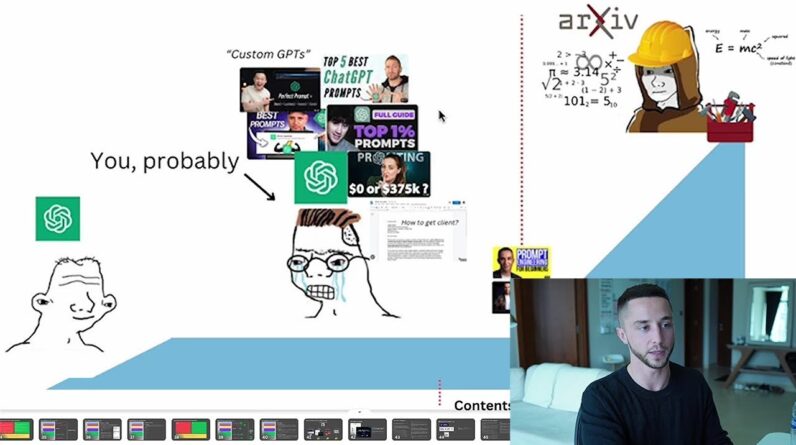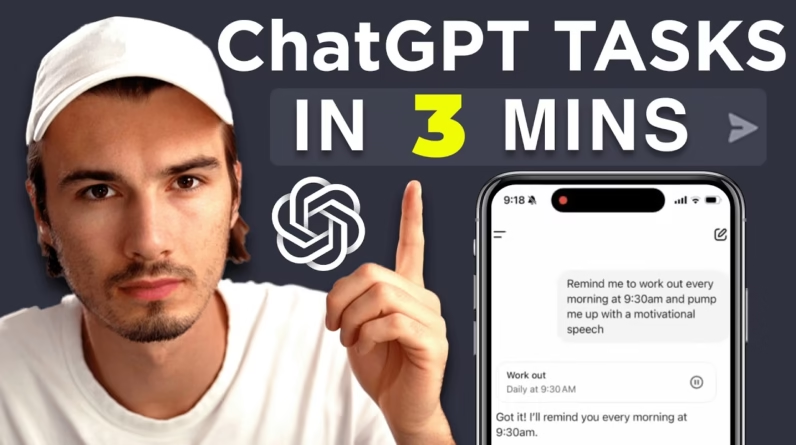
Mastering the art of prompt engineering is crucial for anyone aspiring to thrive in the world of artificial intelligence. This comprehensive guide aims to elevate your skills from a basic understanding to a level where you can adeptly navigate complex AI systems. With insights from the video “Why You Suck at Prompt Engineering (and How to Fix It)” by Liam Ottley, you’ll uncover common pitfalls and discover effective techniques to improve your prompting abilities.
In this article, you’ll explore why many struggle with prompt engineering and the importance of grasping the science behind it. Key techniques will be highlighted, such as the distinctions between conversational and single-shot prompting, the role of specificity, and how real-world applications can significantly boost performance. By honing these skills, you’re setting yourself up for success in the ever-evolving landscape of AI and automation.
Table of Contents
Understanding Prompt Engineering

Definition of Prompt Engineering
Prompt engineering is the process of designing and refining prompts—or inputs—used to communicate with artificial intelligence models, particularly natural language processing (NLP) systems. It’s not just about writing a prompt; it’s about crafting a statement or question that elicits the best possible response from the AI. The goal is to guide the AI in a way that aligns its output with your expectations and needs. By mastering prompt engineering, you essentially become a communicator between human intent and machine understanding, enhancing the interaction’s quality and relevance.
Importance in AI Development
In the rapidly evolving field of artificial intelligence, prompt engineering is becoming increasingly crucial. As AI models grow more sophisticated, the effectiveness of these tools often hinges on how well users can instruct them. Successful AI deployment in business applications, research, or even creative endeavors relies on optimizing prompts. Whether you’re looking to automate customer service, generate content, or analyze data, the correct prompts can vastly improve efficiency and effectiveness. As you engage more deeply with AI, developing robust prompt engineering skills can set you apart in your career or entrepreneurial endeavors.
Common Misconceptions
Many people misunderstand the essence of prompt engineering, believing it to be a simple matter of typing any command and receiving answers. This misconception leads to underperformance in AI-related tasks. Additionally, there’s a tendency to think that prompt engineering only involves using prewritten templates—the “one size fits all” mentality. In reality, each context demands a unique approach to prompts. Therefore, recognizing that prompt engineering is both an art and a science is essential. You need to cultivate an understanding of nuances in language and adapt your strategies accordingly.
The Learning Curve in Prompt Engineering
Understanding the Not-So-Bell Curve
When discussing the learning curve in prompt engineering, it’s useful to think beyond the classic bell curve. Many people start at a basic level of understanding, think they grasp more than they do, and plateau at what is commonly referred to as the “midwit” level. This stage is characterized by an overestimation of one’s skills and leads to misunderstanding the complexities involved in shaping prompts for AI. The true journey requires continuous learning, practice, and humility to acknowledge areas needing improvement.
Midwit Level Understanding Explained
The midwit level often traps individuals in a cycle of trial and error without genuine progress. This occurs when you possess just enough knowledge to make simple prompts but not enough to understand when and why those prompts succeed or fail. You may feel competent using tools like ChatGPT, but if you can’t translate that usage into optimizing your outputs, your skill development stalls. Acknowledging this level is crucial for your growth; it means recognizing that your current abilities are not the endpoint.
Strategies to Overcome Learning Obstacles
To advance your skills beyond this plateau, you can employ several strategies. Start by actively engaging with AI outputs: provide feedback and reflect on why certain prompts yield better results. Experiment with different wording, adjust your approach based on the context, and analyze successful prompts from others. Seeking out resources—like online courses, community discussions, or reading materials—can also provide insights to enhance your prompting techniques. By viewing learning as an evolving journey, you can cultivate a more profound expertise in prompt engineering.
Types of Prompting Techniques
Conversational vs. Single-Shot Prompting
Two primary types of prompting techniques are conversational prompting and single-shot prompting. Conversational prompting is like having an interactive dialogue with the AI. You can ask questions and refine your prompts based on the AI’s responses, allowing for a more forgiving process. This works well for casual engagements or specific tasks where follow-up questions can clarify or redirect.
On the other hand, single-shot prompting requires a more intense focus on crafting the initial input since there will be no back-and-forth interaction. Here, your goal is to frame the prompt in such a way that the AI provides a precise, reliable output without the opportunity for further input. This method is valuable in cases where you need consistent performance in automated tasks.
Role and Task Definition in Prompts
An effective way to enhance the performance of your prompts lies in clearly defining the role and task within them. For instance, specifying “You are an email classification expert” can provide helpful context for the AI and improve accuracy. Likewise, explicitly laying out task requirements using clear descriptors helps the AI understand what you expect. By effectively defining roles and tasks in your prompts, you can achieve better results and higher relevance in the AI’s responses.
Best Practices for Each Prompting Type
To maximize effectiveness with different types of prompts, employ best practices specific to each type. For conversational prompting, practice being context-specific—phrase your follow-up questions understandability rather than leaping too far from previous responses. It’s also beneficial to guide the AI’s direction without overwhelming it with broad questions.
For single-shot prompts, clarity and conciseness are key. Focus on being explicit about what you require from the AI, using specific language and avoiding ambiguity. Thoroughly testing and refining your prompts based on performance will lead to improved results over time. By adhering to these best practices, you’re setting yourself up for success in prompt engineering.
Framework for Effective Prompt Engineering
Transitioning from Basic to Advanced Techniques
Your initial foray into prompt engineering might revolve around trial and error, but to truly excel, you’ll want to develop a structured framework. Begin with basic techniques that involve straightforward prompts, then gradually integrate more complex instructions and context. This progression not only builds your confidence but also enhances your understanding of how advanced techniques can yield better outcomes.
Mastering the Science Behind Prompting
To become proficient in prompt engineering, it’s essential to understand the underlying mechanics of how AI models interpret instructions. Familiarizing yourself with language pattern structures, sentiment analysis, and contextual nuances will enable you to craft prompts that align closely with the capabilities of the AI. By marrying creativity with an analytical mindset, you can leverage the science behind prompting techniques, leading to higher-quality interactions.
Building a Customized Prompt Framework
Developing a personalized prompt framework is invaluable as you refine your skills. Consider your unique needs and projects, and establish a collection of prompts that suit your style while being adaptable for various contexts. Experimenting with this framework can offer valuable insights into what works best for you and your goals, paving the way for more effective AI-human collaboration.
Techniques to Enhance Prompt Performance
Chain of Thought Prompting Explained
A powerful technique in prompt engineering is chain of thought prompting, which involves encouraging the AI to outline its reasoning step-by-step before arriving at a conclusion. By structuring prompts that solicit a logical reasoning process, you can enhance the quality of the output. This method is particularly effective in problem-solving tasks as it cultivates deeper insights and more comprehensive responses.
Using Emotional Stimulus in Prompts
Adding emotional elements to your prompts can significantly enhance performance. When you frame your prompts in a way that conveys urgency or importance, you can motivate the AI to produce more nuanced and thoughtful responses. For example, instead of merely asking for information, you might invoke an emotional connection to the task, increasing the likelihood of a compelling output.
Importance of Specificity in Instructions
One of the most critical aspects of effective prompting is specificity. Vague instructions can lead to ambiguous or irrelevant results. Instead, focus on providing detailed instructions that guide the AI toward producing the desired outcome. By narrowing down your requests and honing in on specific parameters, you position the AI for success in generating content that meets your expectations.
Utilizing Context and Examples
The Role of Context in AI Understanding
Context plays a pivotal role in how AI interprets prompts. By providing context, you equip the AI with crucial background information that can shape its responses meaningfully. When formulating prompts, think about what surrounding information can help the AI understand your expectations better. This approach will lead to outputs that are not only accurate but are also attuned to your specific needs.
Implementing Few-Shot Prompting Techniques
Few-shot prompting is a strategy that entails providing the AI with several example inputs and desired outputs to guide it toward the correct response. By presenting examples, you help establish a framework for the AI to follow, which enhances its ability to generate relevant and accurate results. This technique is especially useful in cases where complex reasoning or specific subjects require clarification.
Examples that Drive Desired Outputs
Compelling examples can drive your expected outputs in prompt engineering. When you provide the AI with examples, you’re essentially illustrating how you want it to respond. These serve as guides that set the standard for the quality and format of the desired results. Crafting your examples thoughtfully can lead to a transformative impact on the AI’s performance.
Leveraging Formatting for Clarity
Using Markdown for Readability
In creating prompts, clear formatting is fundamental. Utilizing Markdown can improve readability and organization, both for yourself and the AI. This formatting style allows you to emphasize important information, break down complex instructions, and maintain a clean structure throughout your prompts. When prompts are easy to read, you’re less likely to encounter miscommunication.
Structuring Final Notes in Prompts
Involving final notes or closing statements in your prompts reinforces your instructions and provides context for any expected outcomes. This serves as a recap or summary that can clarify complex tasks. Ending your prompts with clear, structured final notes ensures that nothing is overlooked and that the AI understands its objectives thoroughly.
Common Formatting Pitfalls to Avoid
While it’s essential to use formatting effectively, there are common pitfalls you should avoid. Complexity can lead to confusion; overusing bold, italics, or other formatting styles may dilute their intended impact. Additionally, aim to maintain a simple, straightforward approach rather than overcomplicating your prompts. Avoid ambiguity and strive for clarity in every interaction.
Real-World Applications of Prompt Engineering
Case Studies in Email Classification Systems
Prompt engineering has immense real-world applications, such as automated email classification systems. Companies often struggle to address incoming emails efficiently. By crafting effective prompts that accurately describe various email types and categorize them accordingly, businesses can deploy AI that automatically sorts and prioritizes these emails, saving valuable time and resources.
Benefits of Optimized Models
Optimized models in AI can vastly improve productivity and efficiency. When the prompts provided to these models are designed thoughtfully and with precision, the resulting outputs align closely with business needs and goals. This optimization can result in better decision-making, reduced operational costs, and overall enhanced performance in significantly less time.
Cost-Reduction and Efficiency Improvements
By adopting effective prompt engineering practices, organizations can experience substantial cost reductions and efficiency improvements. With advanced AI systems that operate reliably on finely-tuned prompts, businesses can minimize manual efforts. This leads to a leaner organizational structure, freeing up resources to focus on strategic initiatives rather than repetitive tasks—ultimately maximizing ROI.
Resources for Continued Learning
Recommended Books and Articles
For those eager to deepen their knowledge in prompt engineering, exploring recommended books and reading materials is essential. Numerous resources cover both foundational concepts and advanced techniques. Engaging with these published works can offer insights into the complexities of AI interactions, enabling you to develop a robust understanding of how to effectively engineer prompts.
Online Courses and Tutorials
Online courses and tutorials stand out as excellent venues for learning prompt engineering. Many platforms offer structured programs that guide you through the elements of prompting techniques and their applications in real-world scenarios. These courses can provide hands-on experiences and practical insights that complement your reading and practice.
Communities and Forums for Prompt Engineers
Joining communities and forums focused on prompt engineering is another way to grow your skills. Engaging with like-minded individuals offers opportunities for discussion, exchanging ideas, and learning from others’ experiences. These networks can become invaluable resources for asking questions, seeking feedback, and sharing advancements in the field.
Conclusion and Recommendations
Recap of Key Points
To conclude, mastering prompt engineering is a skill crucial for anyone working with AI today. By understanding the definitions, importance, types, and practical applications of prompting techniques, you’re laying a solid foundation to excel in this area. The learning curve, while challenging, can be navigated with the right strategies, ultimately leading to enhanced AI interactions.
The Future of Prompt Engineering in AI
As AI technologies evolve, the demand for advanced prompt engineering skills will only increase. Being proficient in this area will open doors to various opportunities in industries harnessing AI’s potential. You have a chance to be at the forefront of these innovations, shaping the future of AI applications and capabilities.
Final Thoughts on Skill Development
Investing time and effort in developing your prompt engineering skills is a worthwhile venture. With commitment and practice, you can master the art and science of effectively communicating with AI systems. So embrace the journey, continue learning, and practice consistently; you’ll find great success in your endeavors in AI and beyond.







